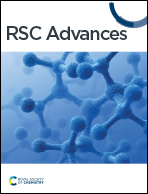Green AOT reverse micelles as nanoreactors for alkaline phosphatase. The hydrogen bond “dances” between water and the enzyme, the reaction product, and the reverse micelles interface†
Abstract
In this work, we present an investigation of the influence of water encapsulated in 1,4-bis-2-ethylhexylsulfosuccinate/methyl laurate and 1,4-bis-2-ethylhexylsulfosuccinate/isopropyl myristate reverse micelles on the enzymatic hydrolysis of 1-naphthyl phosphate by alkaline phosphatase. Our results show that the enzyme is active in the biocompatible reverse micelles studied and that the Michaelis–Menten kinetic model is valid in all systems. We found that both micellar systems studied have a particular behavior toward pH and that the penetration of external solvents into the interfaces is crucial to understanding the effect. Methyl laurate does not disrupt the interface and is not necessary to control the pH value since alkaline phosphatase in the center of the micelles is always solvated similarly. In contrast, isopropyl myristate disrupts the interfaces so that the water and 1-naphthol molecules cannot form hydrogen bond interactions with the polar head of the surfactant. Then, when the water is at pH = 7, the 1-naphthol moves away to the interfaces inhibiting alkaline phosphatase which is not observable when the water is at pH = 10. Our study shows that the concept of pH cannot be used directly in a confined environment. In addition, our research is of great importance in the field of reactions that occur in reverse micelles, catalyzed by enzymes.



 Please wait while we load your content...
Please wait while we load your content...